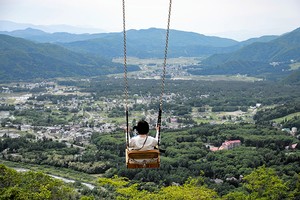THE ASAHI SHIMBUN
April 26, 2021 at 18:22 JST
Commuters were out in force as usual in Tokyo and Osaka Prefecture on the morning of April 26, despite the recently declared third state of emergency over the COVID-19 pandemic.
It was the first weekday since the central government declared the emergency for the capital, as well as Osaka, Hyogo and Kyoto prefectures on April 25, which lasts until May 11.
The government is asking companies to reduce the number of employees reporting to work by 70 percent, but it is unlikely to achieve the target anytime soon.
Beginning around 8 a.m., slews of people clad in face masks could be seen coming and going continuously at a crossing in front of JR Tokyo Station.
A Tokyo Olympics countdown clock installed in the area read 88 days and 12 hours remained before the Opening Ceremony.
“Trains were crowded as usual,” said a man in his 40s who took a train on the Utsunomiya Line before quickly striding across the crosswalk. “I don't think the state of emergency is effective anymore.”
A security guard at a nearby building said, “Even under the emergency declaration, I can’t see any changes (in the volume of foot traffic).”
A man reading a book at a nearby bench before commuting to work said he was surprised at the big difference in people’s attitudes compared to when Japan's first state of emergency was declared a year ago.
“At that time, I was able to find a seat on a train on the normally overcrowded Yamanote Line,” said the 52-year-old financial company worker. “But it was crowded this morning. It's totally different from a year ago.”
Last spring he worked remotely once or twice a week as his company was promoting teleworking. But he said now he feels the company thinks it is enough to just have minimal teleworking among its workforce.
“People are getting used to the novel coronavirus and the state of emergency,” he said. “I think the central government has to enforce its anti-virus measures to some extent to reduce the burden on the health care system.”
Commuters in suits and school uniforms were also seen filling up Osaka’s Umeda district on the morning of April 26.
“Foot traffic was slightly smaller early in the morning, but began gradually increasing from 7 a.m.,” said Takafumi Yamanaka, who sweeps areas around Hankyu Corp.’s Osaka Umeda Station from 5 a.m.
Yamanaka, 60, who has observed the flow of people in front of the station over the past five years or so, said he noticed a difference from the first state of emergency.
“The area was mostly deserted last April as all office buildings around here were closed,” he said. “I don’t think the latest state of emergency will be as effective as the first.”
Another man, 55, who took a train on Hankyu’s Kyoto Line to the Umeda district from Takatsuki, Osaka Prefecture, said, “I was expecting fewer people out and about, but the size of crowds appears to be the same as before the emergency declaration.”
The trains were also crowded as usual, he added.
“Foot traffic plunged when the first state of emergency was issued,” he said. “I wonder if people have already gotten used to the emergency declaration.”
He said he is creating a schedule for remote working shifts at his company.
A university sophomore, 19, who lives in Osaka Prefecture, changed trains at Umeda to commute to her campus in Kobe. She said last April she could take all her classes remotely, but this time she has to attend half on campus.
“The bus was overcrowded this morning,” she said. “I want the university to hold all its classes remotely until the pandemic is brought under control.”
To avoid riding the bus as much as possible, she has recently been walking up a hill on her way to the campus, she said.




















A peek through the music industry’s curtain at the producers who harnessed social media to help their idols go global.
A series based on diplomatic documents declassified by Japan’s Foreign Ministry
Here is a collection of first-hand accounts by “hibakusha” atomic bomb survivors.
Cooking experts, chefs and others involved in the field of food introduce their special recipes intertwined with their paths in life.
A series about Japanese-Americans and their memories of World War II